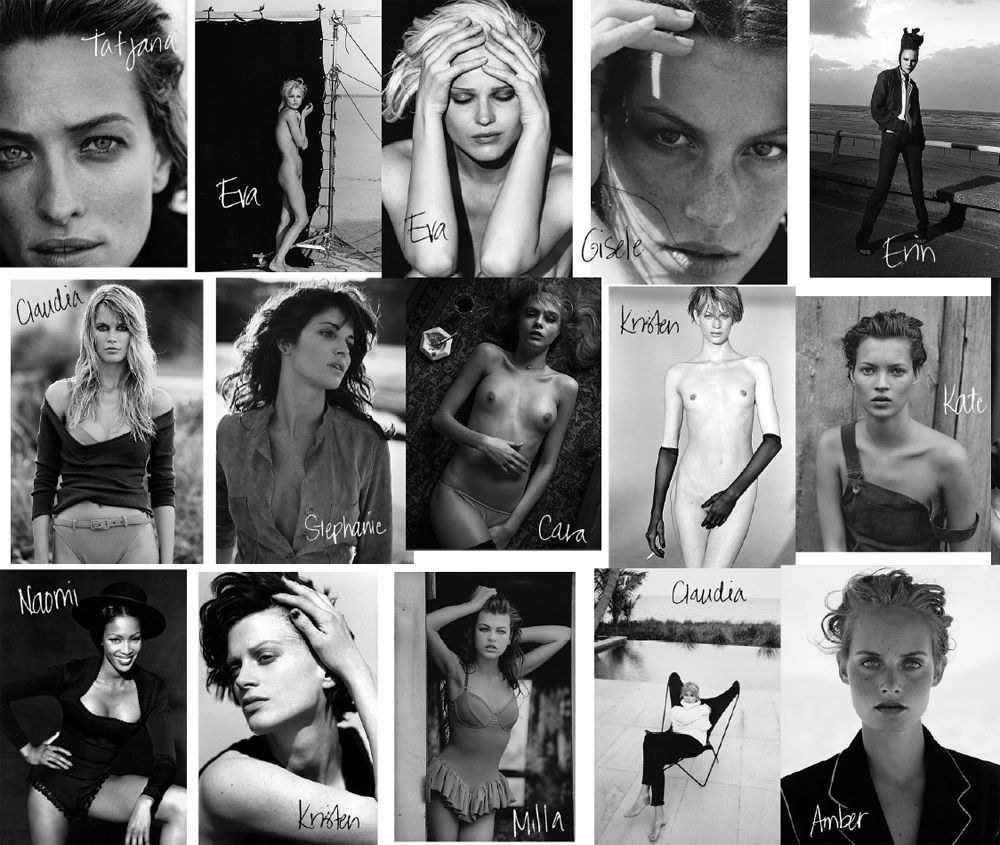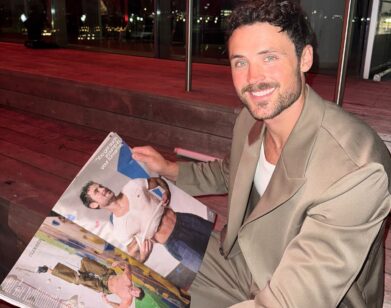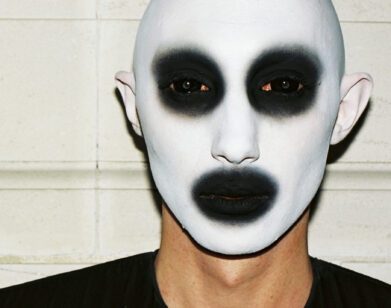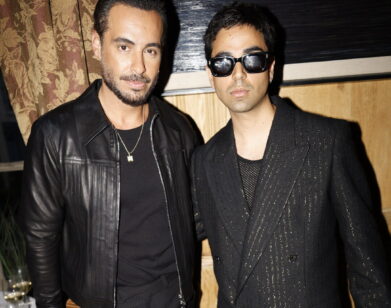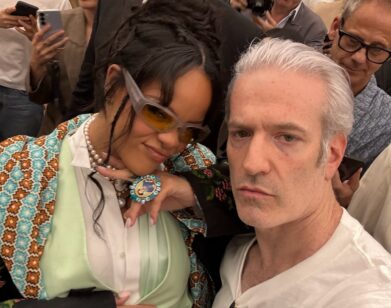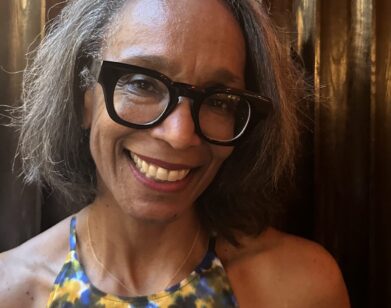The Eye: Peter Lindbergh
I chose the girls I really loved at this time—including Christy and Linda and Tatjana, who were all hip and young and not known at the moment—and we went to L.A. PETER LINDBERGH
It’s tough to say when the supermodel era officially began, but Peter Lindbergh’s role in it is undeniable. There are the black-and-white images that he shot for Vogue in 1988 of a gaggle of girls in white shirts on the beach—including a very young Linda Evangelista, Christy Turlington, and Tatjana Patitz. There is the now—landmark January 1990 cover of British Vogue, for which he photographed Evangelista, Turlington, and Patitz, along with Naomi Campbell and Cindy Crawford, and which established a touchstone for the decade. (Lindbergh calls it the “birth certificate” of supermodeldom.) There are, of course, all of the other indelible photographs that he has taken over the years of early favorites like Lynne Koester, as well as ’90s girls like Claudia Schiffer, Kate Moss, Amber Valletta, and Kristen McMenamy, and more recent ones like Gisele Bündchen and Cara Delevingne, as well as a substantial corpus of fashion stories, campaigns, and other work. He even directed a documentary in 1990 with the imposing-sounding title of Models: The Film, which, by contrast, offers a lighter, more spirited glimpse of Evangelista, Crawford, Patitz, Campbell, and Stephanie Seymour as their careers were first shifting into high gear.
Lindbergh’s great efficacy in producing iconic imagery of supermodels can be attributed, in part, to a mix of sharp instincts, good fortune, and that old chestnut of knowing the right way to shoot the right girl in the right moment. But it also has a lot do with what he captures about them, and his visual treatment of them not as models, but as women. There is a clarity and an emotional frankness to a Lindbergh photograph, even if it’s part of a more fashion- or documentary- oriented story, that somehow reaches for a kind of beauty that exists beyond all of the beautification. His pictures—fashion images included—often have the personal qualities of portraiture, with his subjects eyes and energy at the fore. They are stylized and sexy, but they are also intimate, which is part of the reason why people with big personalities seem to come alive in front of his lens.
Designer John Galliano recently spoke with the 68-year-old Lindbergh, whose work with be exhibited at New York City’s Vladimir Restoin Roitfeld gallery this month, about allowing soul to emerge from the surfaces of fashion, why the exhilaration that comes with the shock of the new can be both a good thing and a bad thing, and his creative life as a man who love to photograph woman.
JOHN GALLIANO: I’m so excited to have you on the phone!
PETER LINDBERGH: I have forgotten everything about my life. Don’t ask me any questions! [laughs]
GALLIANO: How are you?
LINDBERGH: Good. You’re in Mykonos or somewhere in Greece?
GALLIANO: Well, now I’m in Tinos, which is beautiful, but it took us 24 hours to get here from Mykonos because of the winds. I’m staying with a friend who is an artist, and she built the house in the rocks, and it’s just the most awesome place … It made me think of you last night because I went down to the port in these ferocious winds, so I was bracing myself in my hoodie. My hair was a mess and the air is full of salt as if her hair had been done by Odile [Gilbert], and my eyes were squinting like Stéphane Marais eyes. But all of the elements of a Peter Lindbergh photograph were there.
LINDBERGH: [laughs] So you had the whole treatment.
GALLIANO: I had the whole treatment. The only thing that was missing was you being there to capture the moment—and the faith that you and your family inspire that dares to go beyond what the eye can see. But it made me think of you and the faces that you have inspired in us all.
LINDBERGH: I found a great thing recently. Imagine the millions of pictures and photocopies and papers that are in my office—I can’t even walk through the office anymore because there are so many things. Anyhow, I moved some papers from the left to the right, and in a pile, I found a photocopy of a picture that we did together for British Vogue in 1987.
GALLIANO: The one with Christy [Turlington].
LINDBERGH: Yes. It’s brilliant.
GALLIANO: I remember that picture. I think I’d just been awarded that amazing British Designer of the Year honor, and the editor of British Vogue at the time, Liz Tilberis, invited me over to Paris. I had never met you or Julien [d’Ys] or Stéphane [Marais] before, and it was so overwhelming to go into a studio and meet you and then Christy, who was wearing my collection. You sent me a print later. You know, I still treasure that picture, Peter. It has gotten really faded, but it travels with me. It was a fantastic day, just to see you paint with light …
LINDBERGH: That was a very beautiful time—an amazing moment in Paris, an amazing moment in my life, an amazing moment in your life. That was right after you got out of school, correct?
GALLIANO: Yeah, straight after.
LINDBERGH: People pretty well knew how brilliant you were then, John.
GALLIANO: Thank you. You’re making me blush.
LINDBERGH: That’s the way in Greece. [both laugh] But soon after we worked together, I did that famous supermodel picture with the girls in the white shirts for American Vogue—the first supermodels picture ever. [Alexander] Liberman [the longtime editorial director of Condé Nast] had asked me to do it. I don’t know if you know that one.
GALLIANO: This was in the 1990s, no?
LINDBERGH: 1988.
GALLIANO: Right—even earlier.
LINDBERGH: Mr. Liberman was the creative head of Condé Nast at the time, and Grace Mirabella was the editor of Vogue—Carlyne [Cerf de Dudzeele] was there, too. Anyhow, the editors at American Vogue had asked me to shoot for the magazine, and from my Paris point of view, I said, “Oh, no. I can’t.” It’s really awful to say that, but that’s how we thought then because there was a different kind of woman being shown in Vogue at the time—this, kind of over chic, perfect, rich lady. So then Mr. Liberman’s office called me and said, “Can you come to see him? He wants to talk to you in New York.” So I came to New York and went to his office, not knowing anything, and he said, “My editors tell me that you don’t want to work for Vogue. Are you mad? Do you have any idea what you’re refusing? Why don’t you want to work for American Vogue?” And I said, “I can’t handle the kind of woman that you’re photographing in the magazine.” At first, he was astonished, but then he said, “Okay. Why don’t you take one of my editors, whomever you want, and then you go wherever you want and shoot whatever you want—your kind of woman.”
GALLIANO: Oh, we like that. Go on.
LINDBERGH: So I said, “Can I take Carlyne?” because I knew her at the time. He said, “You can take anyone.” So I took Carlyne with me and we went to Los Angeles. I said, “Carlyne, it’s not really about fashion.” She loved all that other stuff—the golden Rolexes and all the jewelry. So I said, “Just take some white shirts.” Then I chose the girls I really loved at this time—including Christy and Linda [Evangelista] and Tatjana [Patitz], who were all hip and young and not known at the moment—and we went to L.A. and did these pictures with the white shirts on the beach. So then I came back with the pictures and showed them to Grace Mirabella and Mr. Liberman at their office. I remember I was very proudly presenting my pictures on the table, [laughs] when they looked at each other, crossing their arms, and said, “Yeah … What should we do with these?” I said, “You asked me to show you the kind of woman I like.” And they said, “Oh … Well, thanks so much.” And then they put them in a drawer.
GALLIANO: [laughs] Really?
LINDBERGH: But then later that year, Anna [Wintour] replaced Grace Mirabella as editor in chief starting with the November issue of ’88—that was her first issue. So Anna came in and saw the pictures, and when I told her what happened, she said, “I would have given you the cover and 20 pages.”
GALLIANO: Well, Anna gets it. She understood that you were capturing the moment.
Over a period of 10 or 12 years, you worked with 10 models at most. There were new faces, but there were those 10 who would blow away everybody else. PETER LINDBERGH
LINDBERGH: What’s interesting is that after that, in ’92, Anna directed the book On the Edge: Images From 100 Years of Vogue, and she put that picture with the white shirts in front of the book as the best picture of the decade. Fashion is about change, don’t you think?
GALLIANO: And you were such an instigator of that change in that particular moment. I just love the creative relationship that has always existed between you and the girls, the designers, the stylists, the hair and makeup people, and this whole family that you’ve built around you. Together, you’ve created this visual vocabulary over the years: Peter’s vocabulary.
LINDBERGH: Because it’s so important to that. People don’t necessarily understand how important it is to have talented people around you, like I had with Stéphane, Julien, Odile, and some others, who understand your point of view as a photographer.
GALLIANO: I know, but I’ve seen your family at work. I’ve thought, what is Julien doing? He’s up at five o’clock in the morning trawling the beach, looking for the perfect fishbone, and you kind of don’t get it. Or Odile mixing this mud—you’re like, “The girl’s hair looks gorgeous. Why are you going to put that dirt in her hair?” And then Stéphane works on the face, and the girl does look a little bit tired, but he enhances that because he knows what you’re seeing through that lenses. The girl becomes woman. So I just love watching that whole thing. And you’re so generous because you teach. In those days, the girls had more time, didn’t they? You worked with them regularly and there was the time for them to launch. I kind of miss that a little bit because everyone wants new now. I think we’re all to blame—the photographers, the designers, the stylists. We all want new, new, new, new. But back then, you had more time to establish a relationship with a girl, for the girl to learn about the light and what you, as the photographer, were seeing. The girl would develop a faith in you, in Odile, in Julien, in Stéphane, and she would understand what she was wearing.
LINDBERGH: Well, over a period of 10 or 12 years, you worked with 10 models at most. There were new faces, but there were those 10 who would blow away everybody else. So you worked with the same people. And someone like Linda Evangelista came into modeling and had her own ideas about what she wanted to do.
GALLIANO: The models were creatively involved.
LINDBERGH: Today, though, so many girls come into the studio and have no idea what’s happening. I mean, often, there are exceptions. But it’s very difficult to work all of the time with fresh people. Now, you work with the same girl twice and people say, “Oh, it’s so boring.” But things weren’t always like that. You used to be able build up something of a creative relationship with the models.
GALLIANO: Absolutely. They were your silent movie stars. The script was the dress, and you directed them. That was the story that came through. I think you all learned so much together. I’m fortunate to have seen firsthand how all that artistry is interpreted through your lens. I’m been on both sides of the camera with you, and I’ve seen what’s real, and then I’ve seen how you’ve gone beyond what the eye sees, how you capture the soul.
LINDBERGH: I’m blushing now.
GALLIANO: Well, we’re two big boys, so we shouldn’t be blushing. We owe it to the girls. [both laugh]
LINDBERGH: The funny thing is that everybody points to the British Vogue cover from 1990, with the five girls, as the moment when the supermodel era began, but it was actually happening two years before, when we did the white-shirt pictures for American Vogue. For British Vogue, though, Liz Tilberis had called and said, “I want you to do the January 1990 cover and to do something that expresses what you think the ’90s are going to be about.” So I took the five girls—Linda, Christy, Tatjana, Naomi Campbell, and Cindy Crawford—and that became the birth certificate of the supermodels. That was the rubberstamp for the era—that cover of British Vogue.
GALLIANO: When was the nude picture that Herb Ritts did where all of those models are embracing each other?
LINDBERGH: Herb did that one a little bit afterwards. Herb was great. We were friends, so Herb said in an interview, “The great thing about Peter is that if he works with a model, I don’t even have to look at her. He worked with her so I just book her.”
GALLIANO: That’s a great compliment.
LINDBERGH: How is your life going at the moment, John?
GALLIANO: I’m doing well. It’s a great journey that I’m on. I’m really grateful and enjoying life and being able to talk to you.
LINDBERGH: You know, as photographers, we do pictures, and people either like them or they hate them. But thinking about the pressure on designers—especially when they’re at a point where they have the whole world looking at them … And then you have the business people saying, “We have 4 percent less sales. What’s wrong with you?” Even if you do the most beautiful things, it’s not enough—you have to sell, too. So it seems like there is so much pressure from every side and it must take a lot to stand up to it. I wouldn’t have lasted two minutes as a designer.
GALLIANO: [laughs] It was an enormous pressure—and, I have to admit, I was perhaps not ready to deal with a lot of it. But I was enjoying what I was doing so much that the creative process is really what carried me through. Everything has a price, though. It was a great experience, but something had to give.
LINDBERGH: Well, I remember days when I would go the Café de Flore with a newspaper because a story I shot in the new Italian Vogue was coming out. I would go to the newsstand and buy it, and I would take a breakfast and watch the people. I was really fucking proud of myself. I would stay there until one o’clock in the afternoon sometimes, enjoying myself, reading the newspaper, seeing the people coming in and out. But things are different now. I mean, where do we get inspiration from now?
GALLIANO: Well, that’s a good question. What do you do to find inspiration now? It sounds to me like you enjoy being sort of voyeuristic and watching the world go by. But what do you do now for inspiration?
LINDBERGH: Like a little dog, you pick up things in the street. I have not taken inspiration from the fashion shows. I don’t even really go to too many of the fashion shows—and have not for 15 years—because I don’t want to be inspired by the same things as everyone else. If everyone is inspired by the same things, then of course, you all do the same pictures. Everybody comes from the show and says, “Military is it this year. Photographers are going to do military stories!” But I’d rather be somewhere totally different and get my inspiration from there. That, for me, is a way to do different pictures.
GALLIANO: I can totally relate. It’s funny because sometimes I’ve missed connecting flights and I’ve ended up stuck in some badly designed airport, so I start watching people, and the things that you see at airports are just incredible from a stylistic point of view. You see people who have left countries with hope, and then you others returning from a crazy holiday with remnants of what they brought with them. You see people from different ethnic cultures, a surfer boy with bleach blond hair, people all dressed up in different kinds of clothing, and everything mixing together and all of these characters crossing. For me, that’s the beginning of a line—of a silhouette, of a collection—and I’m finding that sitting in an airport.
LINDBERGH: I remember the inspiration trips that you like to take, which I’ve always thought were a fantastic idea. To go somewhere where nobody knows you and to keep your eyes open … That was a beautiful concept in terms of putting yourself in a place to be inspired.
GALLIANO: I loved those trips. To be able to immerse yourself in a completely different culture … Sometimes I would get through two or three guides because I wanted to see the real China, the real India—I was fearless. But little by little, we’d get to see real things, which sometimes meant hiking or taking a bus to cross through villages for three days. You’d be traveling and nothing would be happening, but then, all of the sudden, you’d come across a village and a hundred ladies would run out in red saris that were embroidered in gold, and it would be a wedding festival. You can’t see that kind of thing in books, Peter—not in the same way. It’s just a moment where you’re there by chance, where god says, “You’re ready to see this. We’re going to let you see this.”
LINDBERGH: That’s how the first-class trips and lounges kill you. All that stuff keeps you away from the real world by makes everything uniform.
GALLIANO: Yes, you’ve got to get out of the office. It’s essential. Even if it’s just to understand how women live all over the world or to discover different clothes, a different cut, a different drape, or a different way that people put themselves together. All of those kinds of inspirations and influences find their way into your pictures. As I mentioned earlier about Stéphane, with the feline eye and the idea of bracing against the elements … There are real things inspire the artistry of the images, which is part of what makes them so powerful.
LINDBERGH: You can only really invent something if you connect yourself to the real world—whatever that means. It doesn’t even have to be something as exotic as the backstreets of Bombay, but you have to be connected to the real world, and from there, you can find something that becomes your thing. It seems, though, like a lot of photographers sit in their offices or in their studios now and look through fashion magazines and say, “Wow, that story is great! Let’s do something like that!” And when you come to the shoots today, editors or clients will come with a pile of pictures by other people and say, “This is what we want to do.” Then they say, “But it’s only for inspiration. We don’t want to do exactly that.” But 20 minutes later, when everything is done—the hair, the makeup—and you’ve started to shoot, they come with one of those pictures in hand and say, “Let’s start with this one.” As a photographer, what can you say? You can only say, “Fuck off.” No? [Galliano laughs] So that’s how it seems to work today.
GALLIANO: It’s true from a designer’s point of view, too. I’ve had a little time to visit some schools, and you find that the kids are also tearing pages out of magazines and that’s their inspiration. It’s great to like a picture, but you have to try to understand it and get behind it and connect with where it’s coming from. You’ve got to really feel it, which is what you’re saying as well. You need to have your own experience, your own connection, your own vision to create something different.
LINDBERGH: I learned something very early in this business—or whatever this is, because this beautiful thing that we call photography isn’t really a business. But if I was starting to work on a project, like a big story for Franca [Sozzani] for Italian Vogue, I would look at other pictures. But I learned very early that the more I was looking at other pictures, the less I knew what to do myself. So I figured out that you have to set that aside and just sit down, take a pencil and a piece of paper, and think what you want to do. That is the only way, I think, to do things that are important later.
GALLIANO: And even if you did look at those pictures in the beginning, they at least inspired you to go away and come up with another idea. Sometimes, as a photographer or a designer, you also wind up in situations where you have listen to points of view that perhaps you don’t agree with. Ultimately, though, it’s that blank page, isn’t it? You must not be fearful of that blank page.
LINDBERGH: As a designer, what do you think of a photographer who shoots fashion but doesn’t go to fashion shows?
GALLIANO: Well, what the designer shows on the runway are their vision—their way of pulling the clothes together and what they’re feeling at that moment on the type of girl they design for. But it all goes further and deeper and becomes richer when it reaches a photographer like you, Peter, because then it becomes about your interpretation.
LINDBERGH: It’s interesting because I think of myself sometimes as this strange little guy who doesn’t go to fashion shows because I think what designers do is brilliant. But at the same time, I feel like I want to keep a certain distance from it. I feel I need that distance to deliver. That’s why I need that distance. People often say, “You don’t go to fashion shows? What kind of photographer are you? What the hell is the wrong with you, man?” But that’s what I need in order to be who I am.
GALLIANO: Well, it’s a great honor when you are present at a show. And when you are not, one understands.
LINDBERGH: I don’t want us to sound like two old guys talking about the good old times, but do you remember in the ’80s and the ’90s when we sometimes did crazy stories that actually inspired the designers? That is also the job of the photographer, I think.
GALLIANO: A good story can definitely inspire—even if it’s not necessarily the look or what the girls are wearing, but just the esprit. You know, I used to have these bibles for every collection. I don’t have them anymore, but for every collection, I’d produce a research book filled with the kinds of things that inspired me. I have to admit, many of your pictures would be in those books, whether it was for a line or for an attitude or just for a feeling. You can ask the girls—I’d bring out these books and say, “This is the feeling or the character.” It would start a dialogue with them, where they could get into what we were doing or get the vibe. Then I’d say, “Just imagine Peter sitting at the end of the runway.” And the little nose would turn up, and the eyes would become focused, and we’d get it. So you were absolutely an inspiration for me—and continue to be.
LINDBERGH: I’m going to stop blushing and start crying. [both laugh] I have this impression, though, that we have always been there for each other in terms of inspiration, even though we wouldn’t necessarily see each other in daily life.
GALLIANO: Sometimes it’s like that with people, where you catch that even if you don’t necessarily see them every day. I feel like you’re in the room here with me right now.
LINDBERGH: I would be in the room with you, too, if I could because it’s too hot in Paris and I have to shoot a commercial today, but I would really love to be in Greece now with you.
GALLIANO: We’re going to catch up soon for sure.
LINDBERG: Which is a nice way of you to say, “I want to get the off the telephone and have a dip in the pool now …”
GALLIANO: [laughs] You so get it, don’t you?
LINDBERGH: Well, when you come back to Paris, we’ll get together. I did something very clever. I bought the apartment next door, which has a fantastic terrace, so when you’re back, you’ll have to come over and we’ll sit on this terrace and continue this conversation.
GALLIANO: Would love to. I mean, just to catch that pinky-golden glowing light that you get there where everything is reflecting off that Haussmann stone … It’s so beautiful, that light.
LINDBERGH: That’s what I’m talking about.
JOHN GALLIANO IS AN INTERNATIONALLY RENOWN FASHION DESIGNER.

